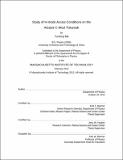| dc.contributor.advisor | Earl S. Marmar and Jerry W. Hughes. | en_US |
| dc.contributor.author | Ma, Yunxing | en_US |
| dc.contributor.other | Massachusetts Institute of Technology. Department of Physics. | en_US |
| dc.date.accessioned | 2013-07-09T19:30:30Z | |
| dc.date.available | 2013-07-09T19:30:30Z | |
| dc.date.copyright | 2013 | en_US |
| dc.date.issued | 2013 | en_US |
| dc.identifier.uri | http://hdl.handle.net/1721.1/79428 | |
| dc.description | Thesis (Ph. D.)--Massachusetts Institute of Technology, Dept. of Physics, 2013. | en_US |
| dc.description | This electronic version was submitted by the student author. The certified thesis is available in the Institute Archives and Special Collections. | en_US |
| dc.description | Cataloged from student-submitted PDF version of thesis. | en_US |
| dc.description | Includes bibliographical references (p. 201-210). | en_US |
| dc.description.abstract | Usually when sufficient heating power is injected, tokamak plasma will make an abrupt transition into a state with improved confinement, known as the high-confinement mode, or H-mode. Given the greatly enhanced fusion yield, H-mode is foreseen as the baseline scenario for the future plasma operation of the International Thermonuclear Experimental Reactor (ITER). Many research efforts have been given to understand the criteria for H-mode access. To further contribute to this research, a primary focus of this thesis is characterizing the H-mode access conditions in the Alcator C-Mod tokamak, across a broad range of plasma density, magnetic field, and plasma current. In addition, dedicated experiments were designed and executed on C-Mod, to explore the effects of divertor geometry, ICRF resonance location, and main ion species on H-mode access conditions. Results from these experiments will be included in this thesis. The underlying physics of H-mode access is very complex, and the critical mechanisms remain largely unresolved. To promote our understanding, some models proposed for the H-mode transition are tested, using well documented local plasma conditions, obtained in C-Mod experiments. In particular, this thesis pioneers the test of a recently developed model for H-mode threshold power predictions. | en_US |
| dc.description.statementofresponsibility | by Yunxing Ma. | en_US |
| dc.format.extent | 210 p. | en_US |
| dc.language.iso | eng | en_US |
| dc.publisher | Massachusetts Institute of Technology | en_US |
| dc.rights | M.I.T. theses are protected by
copyright. They may be viewed from this source for any purpose, but
reproduction or distribution in any format is prohibited without written
permission. See provided URL for inquiries about permission. | en_US |
| dc.rights.uri | http://dspace.mit.edu/handle/1721.1/7582 | en_US |
| dc.subject | Physics. | en_US |
| dc.title | Study of H-mode access conditions on the Alcator C-Mod Tokamak | en_US |
| dc.title.alternative | Study of high performance mode access conditions on the Alcator C-Mod Tokamak | en_US |
| dc.type | Thesis | en_US |
| dc.description.degree | Ph.D. | en_US |
| dc.contributor.department | Massachusetts Institute of Technology. Department of Physics | |
| dc.identifier.oclc | 851061542 | en_US |
